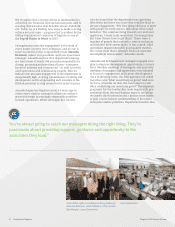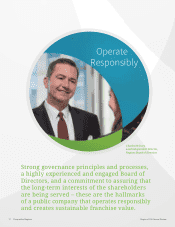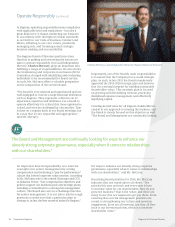Regions Bank 2015 Annual Report Download - page 23
Download and view the complete annual report
Please find page 23 of the 2015 Regions Bank annual report below. You can navigate through the pages in the report by either clicking on the pages listed below, or by using the keyword search tool below to find specific information within the annual report.
Foward-Looking Statements
This 2015 Annual Review, periodic reports led by Regions Financial Corporation under
the Securities Exchange Act of 1934, as amended, and any other written or oral statements
made by us or on our behalf may include forward-looking statements as dened in the
Private Securities Litigation Reform Act of 1995. The terms “Regions,” “the Company,”
“we,” “us” and “our” mean Regions Financial Corporation, a Delaware corporation and
its subsidiaries, when or where appropriate. The words “anticipates,” “intends,” “plans,”
“seeks,” “believes,” “estimates,” “expects,”“targets,” “projects,” “outlook,” “forecast,” “will,”
“may,” “could,” “should,” “can” and similar expressions oen signify forward-looking state-
ments. Forward-looking statements are not based on historical information, but rather
are related to future operations, strategies, nancial results or other developments.
Forward-looking statements are based on management’s current expectations as well as
certain assumptions and estimates made by, and information available to, management
at the time the statements are made. Those statements are based on general assump-
tions and are subject to various risks, and because they also relate to the future they are
likewise subject to inherent uncertainties and other factors that may cause actual results
to dier materially from the views, beliefs and projections expressed in such statements.
Therefore, we caution you against relying on any of these forward-looking statements.
These risks, uncertainties and other factors include, but are not limited to, the risks
described below:
• Current and future economic and market conditions in the United States
generally or in the communities we serve, including the eects of declines in property
values, unemployment rates and potential reductions of economic growth, which may
adversely aect our lending and other businesses and our nancial results and
conditions.
• Possible changes in trade, monetary and scal policies of, and other activities under-
taken by, governments, agencies, central banks and similar organizations, which could
have a material adverse eect on our earnings.
• The eects of a possible downgrade in the U.S. government’s sovereign credit rating or
outlook, which could result in risks to us and general economic conditions that we are
not able to predict.
• Possible changes in market interest rates or capital markets could adversely aect our
revenue and expense, the value of assets and obligations, and the availability and cost of
capital and liquidity.
• Any impairment of our goodwill or other intangibles, or any adjustment of valuation
allowances on our deferred tax assets due to adverse changes in the economic environ-
ment, declining operations of the reporting unit, or other factors.
• Possible changes in the creditworthiness of customers and the possible impairment of
the collectability of loans.
• Changes in the speed of loan prepayments, loan origination and sale volumes, charge-
os, loan loss provisions or actual loan losses where our allowance for loan losses may
not be adequate to cover our eventual losses.
• Possible acceleration of prepayments on mortgage-backed securities due to low inter-
est rates, and the related acceleration of premium amortization on those securities.
• Our ability to eectively compete with other nancial services companies, some of
whom possess greater nancial resources than we do and are subject to dierent
regulatory standards than we are.
• Loss of customer checking and savings account deposits as customers pursue other,
higher-yield investments, which could increase our funding costs.
• Our inability to develop and gain acceptance from current and prospective customers
for new products and services in a timely manner could have a negative impact on
our revenue.
• The eects of any developments, changes or actions relating to any litigation or
regulatory proceedings brought against us or any of our subsidiaries.
• Changes in laws and regulations aecting our businesses, such as the Dodd-Frank Act
and other legislation and regulations relating to bank products and services, as well as
changes in the enforcement and interpretation of such laws and regulations by applica-
ble governmental and self-regulatory agencies, which could require us to change certain
business practices, increase compliance risk, reduce our revenue, impose additional
costs on us, or otherwise negatively aect our businesses.
• Our ability to obtain no regulatory objection (as part of the comprehensive capital analy-
sis and review (“CCAR”) process or otherwise) to take certain capital actions, including
paying dividends and any plans to increase common stock dividends, repurchase com-
mon stock under current or future programs, or redeem preferred stock or other regula-
tory capital instruments, may impact our ability to return capital to stockholders and
market perceptions of us.
• Our ability to comply with stress testing and capital planning requirements (as part of the
CCAR process or otherwise) may continue to require a signicant investment of our man-
agerial resources due to the importance and intensity of such tests and requirements.
• Our ability to comply with applicable capital and liquidity requirements (including,
among other things, the Basel III capital standards and the LCR rule), including our ability
to generate capital internally or raise capital on favorable terms, and if we fail to meet
requirements, our nancial condition could be negatively impacted.
• The Basel III framework calls for additional risk-based capital surcharges for globally
systemically important banks. Although we are not subject to such surcharges, it is
possible that in the future we may become subject to similar surcharges.
• The costs, including possibly incurring nes, penalties, or other negative eects (includ-
ing reputational harm) of any adverse judicial, administrative, or arbitral rulings or pro-
ceedings, regulatory enforcement actions, or other legal actions to which we or any of
our subsidiaries are a party, and which may adversely aect our results.
• Our ability to manage uctuations in the value of assets and liabilities and o-balance
sheet exposure so as to maintain suicient capital and liquidity to support our business.
• Our ability to execute on our strategic and operational plans, including our ability to fully
realize the nancial and non-nancial benets relating to our strategic initiatives.
• The success of our marketing eorts in attracting and retaining customers.
• Possible changes in consumer and business spending and saving habits and the related
eect on our ability to increase assets and to attract deposits, which could adversely
aect our net income.
• Our ability to recruit and retain talented and experienced personnel to assist in the
development, management and operation of our products and services may be aected
by changes in laws and regulations in eect from time to time.
• Fraud or misconduct by our customers, employees or business partners.
• Any inaccurate or incomplete information provided to us by our customers or
counterparties.
• The risks and uncertainties related to our acquisition and integration of other
companies.
• Inability of our framework to manage risks associated with our business such as credit
risk and operational risk, including third-party vendors and other service providers,
which could, among other things, result in a breach of operating or security systems as a
result of a cyber attack or similar act.
Regions 2015 Annual Review23 Perspective Regions


















